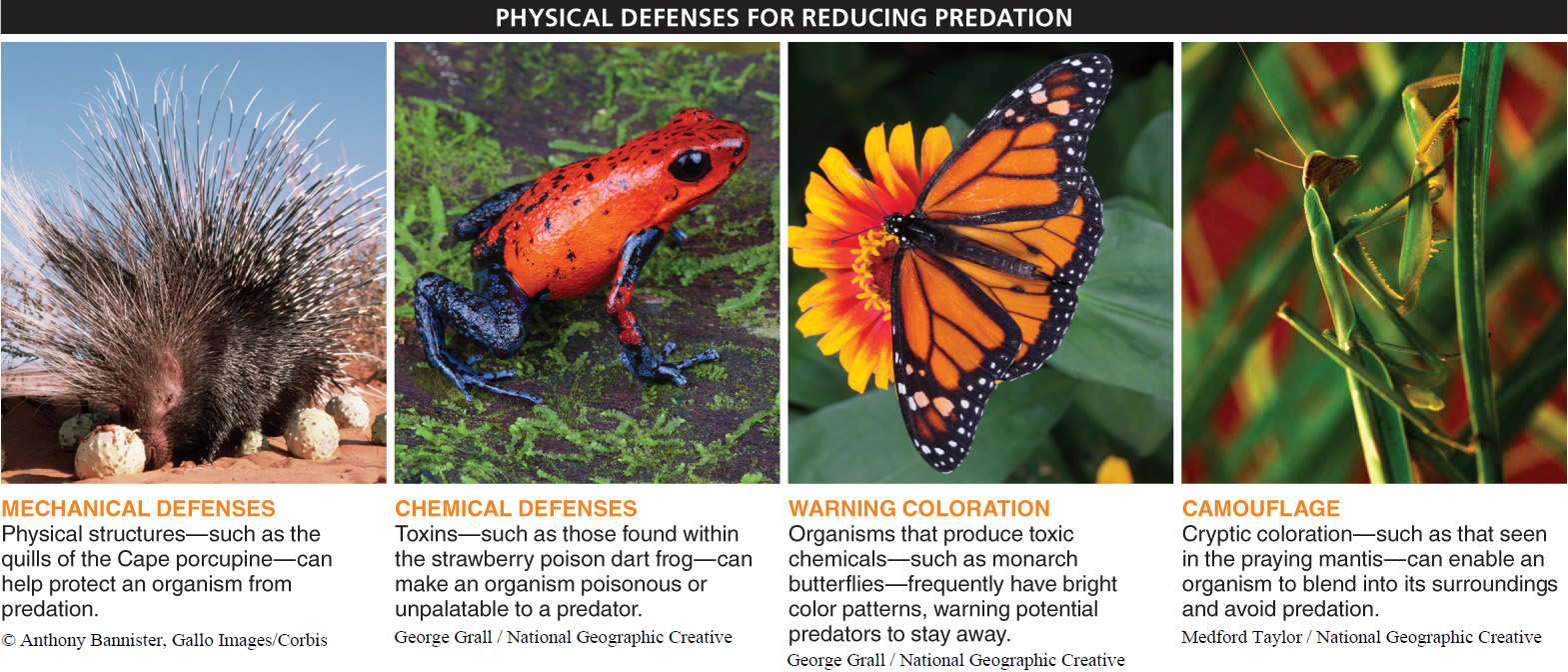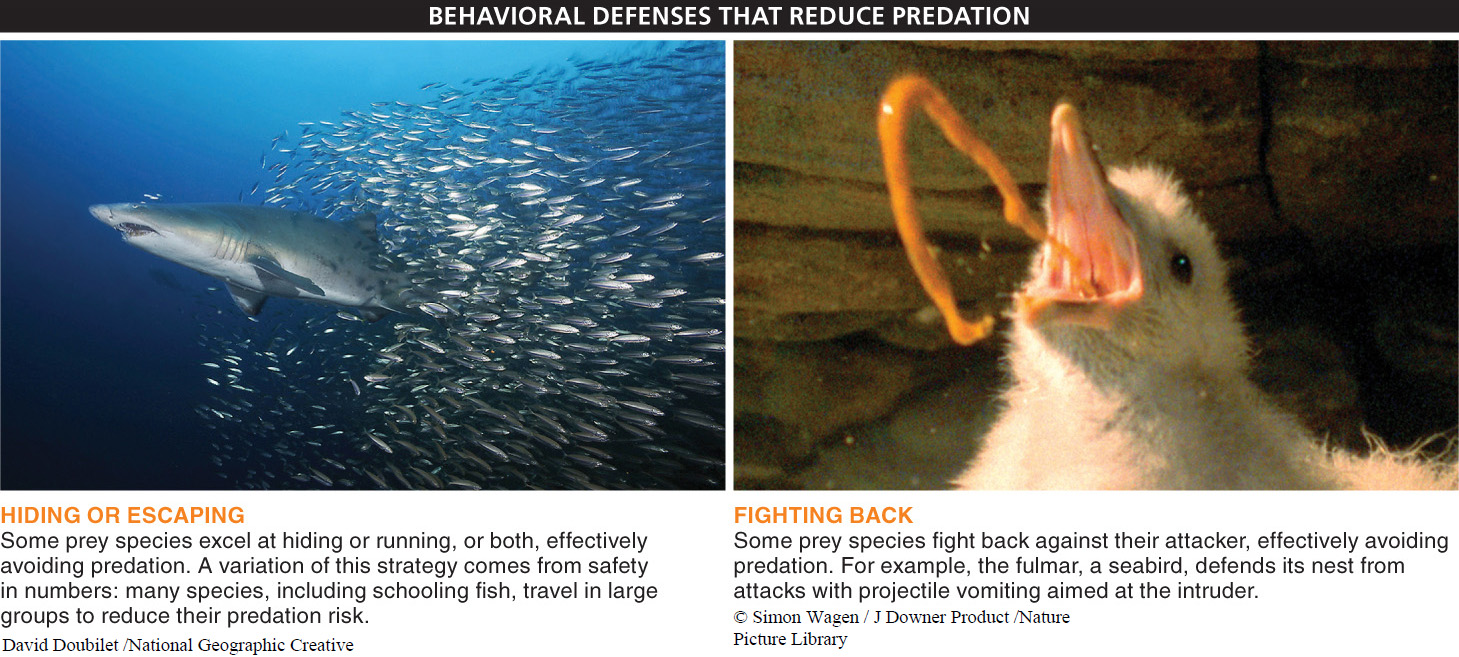Some words of advice in case you ever think about quickly approaching a horned lizard: be afraid. Be very afraid. Here’s why: as you get close to the lizard, it may zap you with streams of blood squirted from its eyes. In all likelihood, you will flinch. And as you flinch, the horned lizard will scurry away. The display is shocking, but the fact that evolution has produced extreme and effective anti-
Predation—an interaction between two species in which one species eats the other—
Why do exotic species often flourish when released into novel habitats, even though natural selection has not adapted them to this new environment?
Predators are a potent selective force: organisms eaten by predators tend to have reduced reproductive success. Consequently, in prey species, a variety of features have evolved (and continue to evolve)—including the blood-
632
Prey adaptations for reducing predation There are two broad categories of defenses against predators: physical and behavioral.
Physical defenses include mechanical, chemical, warning coloration, and camouflage mechanisms (FIGURE 15-24).

1. Mechanical defenses. Predation plays a large role in producing adaptations such as the sharp quills of a porcupine, the prickly spines of a cactus, or the tough armor protecting an armadillo or sow bug. These, as well as claws, fangs, stingers, and other physical structures, can reduce predation risk.
2. Chemical defenses. Further prey defenses can include chemical toxins that make the prey poisonous or unpalatable. Plants can’t run from their predators, so chemical defenses are especially important to them. Almost all plants produce some chemicals to deter organisms that might eat them. The toxins can be severe, such as strychnine from plants in the genus Strychnos, which kills most vertebrates, including humans, by stimulating nonstop convulsions and other extreme and painful symptoms leading to death. At the other end of the spectrum are chemicals toxic to some insects but relatively mild to humans, such as those found in cinnamon, peppermint, and jalapeño peppers. Ironically, many plants that evolved to produce such chemicals to deter predators are now cultivated and eaten specifically for these chemicals. One organism’s toxic poison is another’s spicy flavor.
Some animals can also synthesize toxic compounds (or perhaps, more commonly, can safely acquire them from the organisms they eat). The poison dart frog has poison glands all over its body, making it toxic to the touch. The fire salamander is also toxic, with the capacity to squirt a strong nerve toxin from poison glands on its back. Some animals, including milkweed bugs and monarch butterflies, can safely consume toxic chemicals from plants and sequester them in their tissues, becoming toxic to predators who try to eat them.
3. Warning coloration. Species protected from predation by toxic chemicals frequently have bright color patterns to warn potential predators, essentially carrying a sign that says “Warning: I’m poisonous—
In a clever twist on this, some species that are perfectly edible to their predators also have the same bright colors, in a phenomenon known as mimicry. As long as they are relatively rare compared with the toxic individuals they mimic—
633
4. Camouflage. An alternative to warning coloration, and one of the most effective ways to avoid being eaten, is simply to avoid being seen. An adaptation in many organisms is patterns of coloration that enable them to blend into their surroundings. Examples include insects that look like leaves or twigs and hares that are brown for most of the year but turn white when there is snow on the ground.
Behavioral defenses include both seemingly passive and active behaviors: hiding or escaping, and alarm calling or fighting back (FIGURE 15-25).

1. Hiding or escaping. Anti-
On islands, animals frequently have no fear of humans. Why?
On many islands, animals show no fear of humans. Rather than encountering skittish lizards, for example, a human visitor to the Galápagos Islands must be careful not to step on them. The animals are not afraid because, given the small size of most islands, the number of predators is restricted. As a consequence, there has been no selection for skittishness and hypervigilance, traits that normally evolve in response to predation risk.
2. Alarm calling and fighting back. In many species, especially birds and mammals, individuals warn others with an alarm call. Although risky for the caller, such alarm calling can give other individuals—
Predator adaptations for enhancing predation Just as prey use physical and behavioral features to reduce their risk of predation, predators evolve in parallel ways to increase their efficiency. As milkweed plants have evolved to produce toxic chemicals, sequestered within the structures of the plant, milkweed bugs have evolved to be able to eat the toxic plants without suffering harm. And as prey have become better at hiding and escaping, predators have developed better sensory perception to help them detect hiding prey and faster running ability to catch them. Predators, too, make use of mimicry. The angler fish, tasseled frogfish, and snapping turtle all have physical structures that mimic something—

634
Why don’t predators become so efficient at capturing prey that they drive the prey to extinction?
Although natural selection leads to predators with effective adaptations for capturing prey, the adaptations are rarely so efficient that the prey species are driven to extinction. The explanation for this is referred to as the “life-
TAKE-HOME MESSAGE 15.12
Predators and their prey are in an evolutionary arms race; as physical and behavioral features evolve in prey species to reduce their predation risk, predators develop more effective and efficient methods of predation. This coevolutionary process can result in brightly colored organisms, alarm calling, and many types of mimicry.
Behavioral adaptations exhibited by organisms in order to reduce predation include hiding or escaping, alarm calling, and/or fighting back. List two physical adaptations exhibited by organisms in order to reduce predation.
Physical adaptations exhibited by prey include: mechanical defenses, such as the quills of a porcupine; chemical defenses, such as the toxin strychnine produced by certain plants; warning coloration, such as that found on monarch butterflies; and camouflage, such as that found in many leaf- or twig-resembling insects.